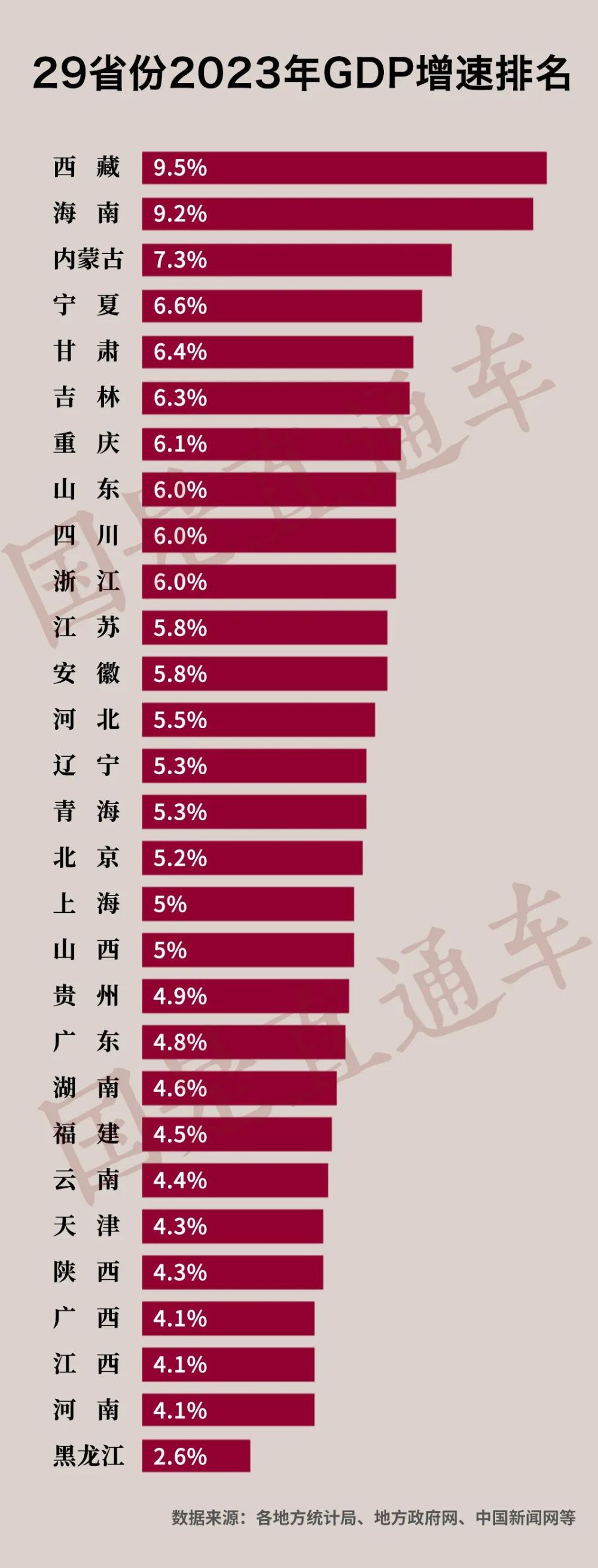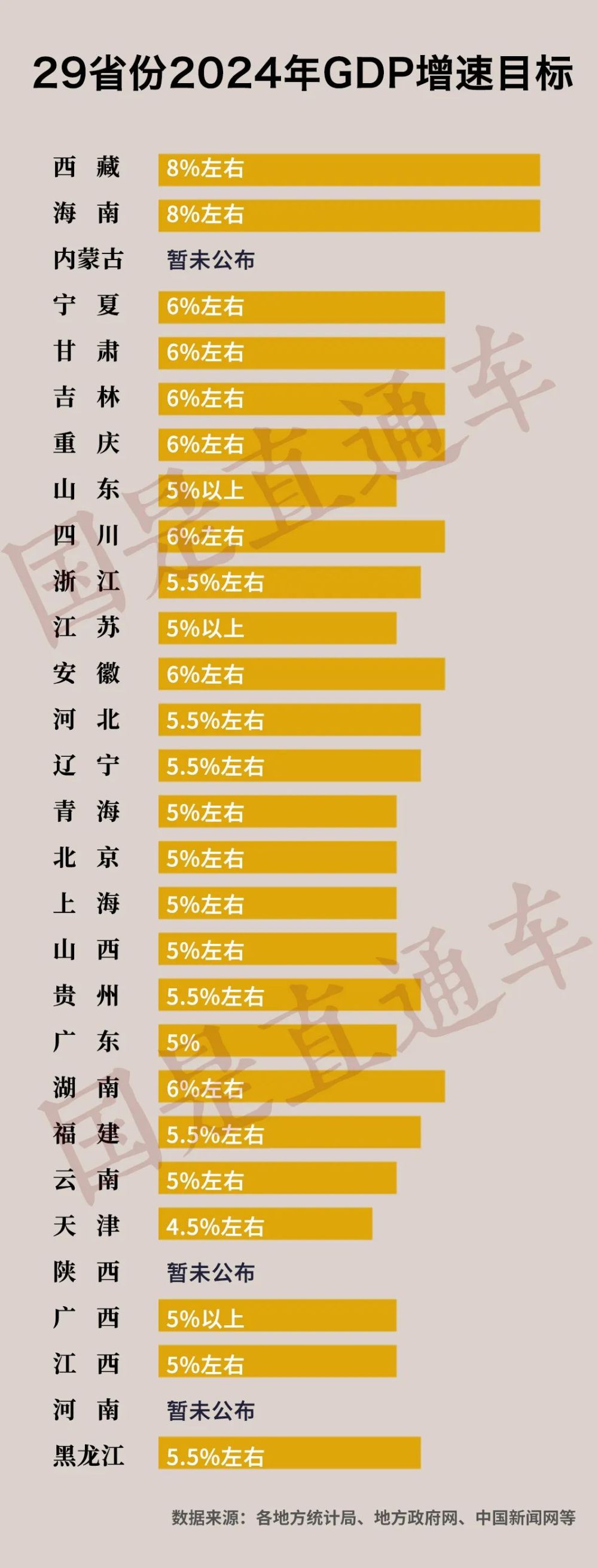The GDP of 29 provinces in China was released: the first 13 trillion province was born!
As many places in the country enter the "two sessions" in 2024, various places have also announced the "annual report" of the economy in 2023.
As of January 25th, 29 provinces (autonomous regions and municipalities) have announced the annual economic performance in 2023. Judging from the published information, the growth rate of 15 provinces has outperformed the whole country.
The growth rate of 15 provinces outperformed the whole country
Statistics from the National Bureau of Statistics show that the gross domestic product (GDP) of China in 2023 was 126,058.2 billion yuan, an increase of 5.2% over the previous year at constant prices.
The reporter consulted the work reports of local governments and the official data of statistical departments and found that among the 31 provinces, autonomous regions and municipalities in China, except Xinjiang Uygur Autonomous Region and Hubei, the growth rate of 15 provinces outperformed the whole country in 2023, while Beijing was the same as the whole country. All provinces with disclosed data have achieved positive GDP growth.
Specifically, Tibet’s GDP growth rate reached 9.5%, temporarily leading the country; Hainan, which followed closely, grew by 9.2%; Inner Mongolia ranked third with a growth rate of 7.3%. Other provinces with growth rates above 6% include Ningxia, Gansu, Jilin, Chongqing, Shandong, Sichuan and Zhejiang.

Multi-provincial GDP has reached a new level.
Present potential of western China
Looking through the "transcripts", we can find that the economic development of many places has reached a new level. Guangdong, Jiangsu and Shandong accounted for the top three economic aggregates of China Province in 2023, all exceeding 9 trillion yuan. In particular, Guangdong, as the largest province in economy, became the first province in China to exceed 13 trillion yuan in annual GDP, ranking first in the country for 35 consecutive years.
The economic aggregates of Shandong and Zhejiang, two other major economic provinces, have also leapfrogged, with annual GDP exceeding 9 trillion yuan and 8 trillion yuan respectively. Hunan’s annual GDP exceeded 5 trillion yuan for the first time. Liaoning has successfully entered the "3 trillion GDP Club", surpassing the national growth rate for the first time in 10 years.
In addition, the rise of the western region is obvious. In addition to Tibet, where the economic growth rate leads the country, the growth rates of Ningxia and Gansu both exceed 6%, and Ningxia even announced that all economic indicators are the best in the past years; Sichuan and Chongqing announced that their GDP exceeded 6 trillion yuan and 3 trillion yuan respectively, and the Chengdu-Chongqing double circle as a whole reached a new level. Yunnan’s GDP exceeded 3 trillion yuan for the first time, and Qinghai’s economic growth rate was 5.3%, which also outperformed the whole country.
"Trillion City" expanded by 3 trillion into a new benchmark
Cities also provide a new perspective for observing China’s economy in 2023, among which the most striking thing is that the "GDP Trillion Club" welcomes the new again.
After Changzhou, Jiangsu, and Yantai, Shandong successively announced that they had broken through one trillion yuan, the number of "GDP trillion clubs" in China has increased to 26. Among them, Jiangsu has five "trillion cities", surpassing Guangdong and becoming the province with the largest number of trillion cities in China. From the perspective of urban agglomerations, the Yangtze River Delta and the Pearl River Delta with strong economic vitality have also become "trillion cities" gathering areas, with 9 and 4 respectively.
At the same time, "3 trillion" is also becoming a new starting point for competition among domestic head cities.
Chongqing and Guangzhou announced that the regional GDP will break the 3 trillion yuan mark in 2023. After Shanghai, Beijing and Shenzhen, the number of "3 trillion GDP clubs" in China has expanded to five. Chongqing became the first city in the western region whose GDP exceeded 3 trillion yuan, while Guangzhou was the second city in Guangdong Province after Shenzhen.
Set goals in various places to make progress steadily.
After the economic aggregates of many provinces and cities reached a new level in 2023, how to set economic targets in 2024 attracted people’s attention. Of the 29 provinces that have disclosed data, 26 mentioned the growth target in 2024 in their government work reports.
Up to now, Tibet and Hainan, the two provinces with the fastest GDP growth in 2023, have the highest growth expectations this year, both of which are around 8%. Most other provinces that have disclosed data have set the regional target of economic growth in the range of 5%-6%.
For example, Guangdong, Jiangsu and Shandong, which ranked the top three in China in 2023, have all aimed at the figure of 5% this year. Among them, the goal of Guangdong is set at "5%", while Jiangsu and Shandong should strive for "more than 5%". The expected target of Tianjin’s economic growth rate is below 5%, which is set at around 4.5%, but it is still higher than its economic growth rate of 4.3% in 2023.

The goal has been set, and the key to the future lies in how to accomplish it. When planning the road map for development in 2024, many places showed strong interest in emerging industries, and new quality productivity and new industrialization became the focus of attention.
Shanghai: We will actively promote new industrialization, cultivate and upgrade high-end industrial clusters such as new energy vehicles, high-end equipment, advanced materials, civil aviation and space information, and accelerate the construction of future industrial leading areas.
Chongqing: Insist on putting the high-quality development of manufacturing industry in a more prominent position, persistently grasp the leading belt ecology, promote industrial agglomeration, technological innovation and integrated development, and vigorously cultivate new quality productivity.
Promoting consumption is still the key work in the work reports of many provincial governments.
Jiangsu: Vigorously develop digital consumption, green consumption, healthy consumption, sports and leisure consumption, increase the cultivation and promotion of new consumption formats of cultural tourism, and create more domestic "trendy products" and brand-new consumption scenarios.
Beijing: We should "make great efforts to stimulate potential consumption", promote the transformation and upgrading of traditional business districts, build an international consumption experience zone, boost bulk consumption, cultivate "fashionable products" of domestic products, support the development of service consumption, and promote the integration of diversified consumption formats.